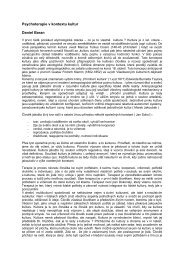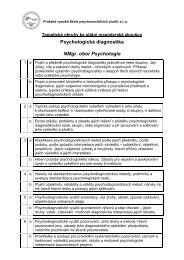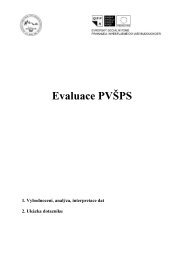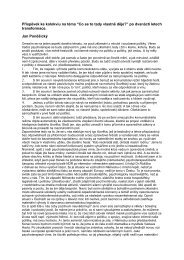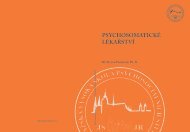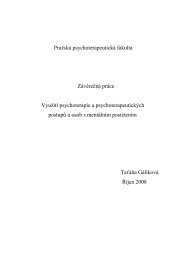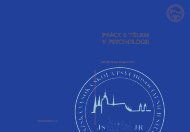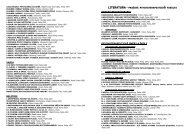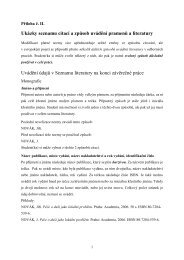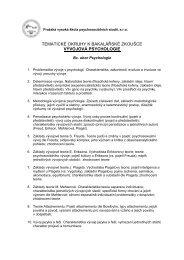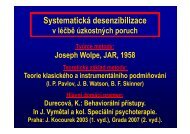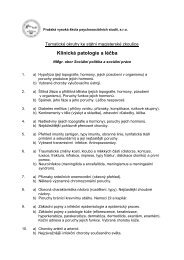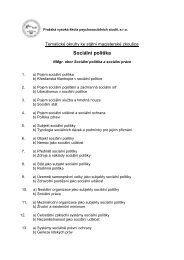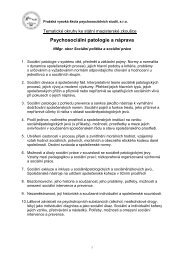New Sources of Fear in a Late Modern Society: The Globalization of ...
New Sources of Fear in a Late Modern Society: The Globalization of ...
New Sources of Fear in a Late Modern Society: The Globalization of ...
Create successful ePaper yourself
Turn your PDF publications into a flip-book with our unique Google optimized e-Paper software.
7<br />
NEW SOURCES OF FEAR IN A LATE MODERN SOCIETY 105<br />
<strong>New</strong> <strong>Sources</strong> <strong>of</strong> <strong>Fear</strong> <strong>in</strong> a <strong>Late</strong><br />
<strong>Modern</strong> <strong>Society</strong>:<br />
<strong>The</strong> <strong>Globalization</strong> <strong>of</strong> Risk<br />
Mart<strong>in</strong> Kuška<br />
Summary. – <strong>The</strong> work exam<strong>in</strong>es the notion <strong>of</strong> fear from an <strong>in</strong>terdiscipl<strong>in</strong>ary<br />
perspective, while stand<strong>in</strong>g at the boundary between sociology and<br />
cultural studies and work<strong>in</strong>g with the psychological concept <strong>of</strong> fear. It del<strong>in</strong>eates<br />
fear as differentiated from anxiety and exam<strong>in</strong>es new sources <strong>of</strong> fear,<br />
which are viewed as the specific socio-cultural stimuli <strong>of</strong> fear. It is precisely<br />
the socio-cultural and also the situational context <strong>of</strong> fear that plays a key<br />
role dur<strong>in</strong>g experiences <strong>of</strong> and cop<strong>in</strong>g with fear. <strong>The</strong> ma<strong>in</strong> focus <strong>of</strong> the work<br />
stems primarily from the writ<strong>in</strong>gs <strong>of</strong> Beck, Füredi and Giddens and centers<br />
on the mapp<strong>in</strong>g <strong>of</strong> the socio-cultural causes <strong>of</strong> fear. It also exam<strong>in</strong>es specific<br />
perceptions <strong>of</strong> contemporary risks such as new fear stimuli while also<br />
reveal<strong>in</strong>g their sources <strong>in</strong> contemporary Western society, characterized as<br />
a world risk society, marked by a specific culture <strong>of</strong> fear. <strong>New</strong> fear stimuli<br />
are presented primarily by experts through the media. In itself, fear is an attractive<br />
commodity (news, c<strong>in</strong>ema) and also has the potential to foment the<br />
desired consumer or voter behavior. <strong>The</strong> <strong>in</strong>dividual is ever more subjected to<br />
fearful <strong>in</strong>formation and is <strong>of</strong>fered cop<strong>in</strong>g strategies centered on the purchase<br />
<strong>of</strong> security products and services, <strong>in</strong>surance, health products, legal services,<br />
expert counsel<strong>in</strong>g, and motivation towards a preference for politicians that<br />
promise to manage these media articulated fears.<br />
Def<strong>in</strong><strong>in</strong>g fear is far from easy. <strong>The</strong>re are numerous specific def<strong>in</strong>itions<br />
<strong>of</strong> fear, which have emerged on the basis <strong>of</strong> <strong>in</strong>dividual paradigms <strong>in</strong> which fear<br />
can be found. A universal def<strong>in</strong>ition <strong>of</strong> fear, which could be used across the various<br />
discipl<strong>in</strong>es, has likely not yet been constructed. One <strong>of</strong> the more recent attempts<br />
This work was supported by the Czech Science Foundation (GAČR 406/09/0294).
106<br />
NEW SOURCES OF FEAR IN A LATE MODERN SOCIETY<br />
to provide a universal def<strong>in</strong>ition <strong>of</strong> fear ended with the statement, “It is my pessimistic<br />
conclusion that fear is not def<strong>in</strong>able at the present time” (Matthen, 1998, p. 106). <strong>The</strong><br />
difficulties associated with def<strong>in</strong><strong>in</strong>g fear stem from attempts to grasp the concept <strong>in</strong> an<br />
<strong>in</strong>terdiscipl<strong>in</strong>ary manner: Matthen comments upon this as a “clash <strong>of</strong> methodologies<br />
used <strong>in</strong> the study <strong>of</strong> emotions” (1998, p. 105), assum<strong>in</strong>g the perspective <strong>of</strong> a philosopher<br />
weigh<strong>in</strong>g, from an evolutionary perspective, the contradictions and paradoxes which<br />
emerge dur<strong>in</strong>g comparisons <strong>of</strong> the methodologies <strong>of</strong> ethnologists and psychologists to<br />
the notion <strong>of</strong> fear. <strong>The</strong> need arises to catalogue fear among biological universals and<br />
Matthen ends his particularly thought-provok<strong>in</strong>g text with these words: “It really is the<br />
bus<strong>in</strong>ess <strong>of</strong> empirical science to furnish the basis <strong>of</strong> a biological def<strong>in</strong>ition <strong>of</strong> fear, and the<br />
result may well not be a perfect fit with the <strong>in</strong>tuitions <strong>of</strong> philosophers” (Matthen, 1998,<br />
p. 132).<br />
“Genes and environment, biological and social sciences, the theory <strong>of</strong> learn<strong>in</strong>g<br />
and the complexities <strong>of</strong> drug addiction, hormones and neurons, personality traits<br />
and psychopathology” (Gray, 1987, p. vii) – Thus, it is possible to study fear from<br />
all <strong>of</strong> these viewpo<strong>in</strong>ts and perhaps more. <strong>Fear</strong> is undoubtedly an emotion to which<br />
psychology pays relentless attention and names such as Basowitz, Cattell, Freud,<br />
Izard, Lazarus, Levitt, Plutchik, Spielberger and Watson belong among the giants<br />
<strong>of</strong> the field and cannot be overlooked dur<strong>in</strong>g the study <strong>of</strong> this emotion. Drvota and<br />
Vymětal belong among the Czech authors, who have devoted particular efforts to<br />
study<strong>in</strong>g this subject. <strong>The</strong> latter def<strong>in</strong>es fear as “an unpleasant experience tied to<br />
a specific object or situation, which creates a concern regard<strong>in</strong>g peril <strong>in</strong> the <strong>in</strong>dividual.<br />
Thus, it is a reaction to known dangers and has a signal<strong>in</strong>g and defensive<br />
function. As an experience, the emotion encompasses tension, disquiet, tightness<br />
and even paralysis” (Vymětal, 2004, p. 12).<br />
<strong>The</strong> likely simplest possible approach to the study <strong>of</strong> fear is <strong>of</strong>fered by radical<br />
behaviorists, who would likely do just as well without the term fear and <strong>in</strong>stead<br />
rely on avoidance behavior. Gray (1987, p. 34) notes that: “the attempt to def<strong>in</strong>e<br />
fear as avoidance behavior is usually preparatory to the conclusion - very welcome<br />
to the radical behaviorists, who want noth<strong>in</strong>g to <strong>in</strong>tervene between stimulus<br />
and response – that we have no need for the concept <strong>of</strong> fear at all, s<strong>in</strong>ce we can always<br />
talk <strong>of</strong> avoidance behavior <strong>in</strong>stead”. So is the term fear really unnecessary?<br />
So long as we merely study the <strong>in</strong>ter-relationships <strong>of</strong> the stimulus-response, we<br />
can do without the term fear. <strong>The</strong> basic questions, with which we beg<strong>in</strong> the study<br />
<strong>of</strong> fear, can be described thus: “(1) what are the conditions which give rise to fear?<br />
(2) what are the conditions which affect susceptibility to fear, or ‘fearfulness’?”<br />
(Gray, 1987, p. 2). Gray (1987, p. 2) prefers “to regard fear as a state, not <strong>of</strong> m<strong>in</strong>d,<br />
but <strong>of</strong> the neuro-endocr<strong>in</strong>e system” – with which we are <strong>in</strong> agreement.<br />
<strong>Fear</strong> is <strong>of</strong>ten connected with anxiety. It can be argued that these two terms need<br />
not always be differentiated. But how to def<strong>in</strong>e the differences between fear and
NEW SOURCES OF FEAR IN A LATE MODERN SOCIETY 107<br />
anxiety? “<strong>Fear</strong> differs from anxiety primarily <strong>in</strong> hav<strong>in</strong>g an identifiable elicit<strong>in</strong>g<br />
stimulus” (Öhman, 2000, p. 574). Miceli & Castelfranchi (2005) represent examples<br />
<strong>of</strong> those who have sought to determ<strong>in</strong>e the differences between fear and<br />
anxiety; they note that “the difference between fear and anxiety lies <strong>in</strong> their different<br />
objects: Whereas the object <strong>of</strong> fear is a (possible or certa<strong>in</strong>) danger, the object<br />
<strong>of</strong> anxiety is an event which implies a possible and uncerta<strong>in</strong> danger” (Miceli<br />
& Castelfranchi, 2005, p. 309). <strong>The</strong> relationship between fear and anxiety has a<br />
dynamic, which the authors describe thus: “As negative expectancies <strong>in</strong>crease,<br />
anxiety proper is replaced by fear. In fact, ... we assume that if threat uncerta<strong>in</strong>ty<br />
decreases <strong>in</strong> the direction <strong>of</strong> negative certa<strong>in</strong>ty, also anxiety decreases, while at<br />
the same time it may be replaced by fear” (Miceli & Castelfranchi, 2005, p. 307).<br />
<strong>The</strong> demarcation <strong>of</strong> fear and anxiety from the perspective <strong>of</strong> behaviorists can<br />
be summarized thus: “Anxiety ... is a future-oriented emotion characterized by<br />
negative affect and apprehensive anticipation <strong>of</strong> potential threats, and results <strong>in</strong><br />
hyper-vigilance and somatic tension (e.g. muscle tension). <strong>Fear</strong> mobilizes the organism<br />
to take action (fight/flight response), whereas anxiety leads to <strong>in</strong>creased<br />
environmental and somatic scann<strong>in</strong>g that facilitates sensory receptivity” (Rhudy<br />
& Meagher, 2000, p. 65).<br />
SOURCES OF FEAR<br />
Our report below focuses on the new sources <strong>of</strong> fear, which we view as the specific<br />
socio-cultural stimuli <strong>of</strong> fear. In a given context, it is necessary to specify that<br />
we primarily concern ourselves with the first and also partially with the second <strong>of</strong><br />
the three different ways suggested by Gray for the study <strong>of</strong> fear: “First, there is the<br />
question <strong>of</strong> which stimuli can <strong>in</strong>nately arouse fear. Secondly, there is the question<br />
<strong>of</strong> what forms <strong>of</strong> behaviour <strong>in</strong>nately occur <strong>in</strong> states <strong>of</strong> fear. Thirdly, there is the<br />
question <strong>of</strong> extent to which an <strong>in</strong>dividual’s particular degree <strong>of</strong> susceptibility to<br />
fear is determ<strong>in</strong>ed by heredity or environment” (Gray, 1987, p. 6). Nonetheless,<br />
we believe that it is precisely the third way that <strong>of</strong>fers an <strong>in</strong>terest<strong>in</strong>g potential for<br />
further empirical research.<br />
Of the oldest sources, it is certa<strong>in</strong>ly worthwhile to rem<strong>in</strong>d ourselves <strong>of</strong> a not-so-<br />
-well-known typology <strong>of</strong> fear: “(1) fears <strong>in</strong> which <strong>in</strong>st<strong>in</strong>ct plays the chief role; (2)<br />
fears which are caused by some pa<strong>in</strong>ful sensation; (3) fears due to some pa<strong>in</strong>ful<br />
or disagreeable idea or belief” (Morse, 1907, p. 51). <strong>The</strong> concrete fears, which the<br />
author concerns himself with are described by him thus: fear <strong>of</strong> high places and<br />
fall<strong>in</strong>g; <strong>of</strong> los<strong>in</strong>g orientation; <strong>of</strong> closeness, celestial objects; <strong>of</strong> darkness; <strong>of</strong> solitude;<br />
<strong>of</strong> water; <strong>of</strong> w<strong>in</strong>d, fire, thunder and lightn<strong>in</strong>g; <strong>of</strong> animals; <strong>of</strong> eyes; <strong>of</strong> teeth; <strong>of</strong><br />
fur; <strong>of</strong> feathers; <strong>of</strong> diseases; <strong>of</strong> death; <strong>of</strong> the end <strong>of</strong> the world, ghosts; <strong>of</strong> poverty.
108<br />
NEW SOURCES OF FEAR IN A LATE MODERN SOCIETY<br />
He also lists miscellaneous fears, to which, for example, he adds fears <strong>of</strong> accidents<br />
(drown<strong>in</strong>g, burn<strong>in</strong>g, that the cars would run <strong>of</strong>f the track, be<strong>in</strong>g killed by runaway<br />
horses, hurricanes, earthquakes), fears <strong>of</strong> f<strong>in</strong>ancial losses, <strong>of</strong> disesteem, <strong>of</strong> stand<strong>in</strong>g<br />
exam<strong>in</strong>ations and even moral and religious fears (Morse, 1907).<br />
Eighty years later, Gray (1987, p. 25) recommends that we “classify the stimuli<br />
for fear <strong>in</strong>to those which are distal and <strong>in</strong>tense; novel; characteristics <strong>of</strong> special<br />
evolutionary dangers; aris<strong>in</strong>g dur<strong>in</strong>g social <strong>in</strong>teraction with non-specifics; or<br />
conditioned by fear”.<br />
COPING WITH FEAR: AN INTRODUCTION<br />
<strong>The</strong> efforts <strong>of</strong> Man to manage his fears are as old as mank<strong>in</strong>d itself. However,<br />
ridd<strong>in</strong>g oneself <strong>of</strong> fear entirely has been proven to be both impossible and decidedly<br />
unnatural. <strong>The</strong> active search for security as a k<strong>in</strong>d <strong>of</strong> antithesis to fear is a basic component<br />
<strong>of</strong> human history as well as the history <strong>of</strong> the <strong>in</strong>dividual human. Riemann<br />
(2010) <strong>in</strong>troduces these strengths, which act aga<strong>in</strong>st fear and help to regulate them:<br />
courage, trust, resolution, strength, hope, humility, faith and love. <strong>The</strong> supernatural,<br />
religion and science also help, he suggests, manage and cope with fear.<br />
In a universal sense, it is possible to state that cop<strong>in</strong>g strategies primarily relate<br />
to anxiety and not fear. “If I don’t know what I am afraid <strong>of</strong>, I am experienc<strong>in</strong>g<br />
anxiety, not fear. But this does not permit to fix a clear boundary between fear and<br />
anxiety, because whereas fear necessarily concerns def<strong>in</strong>ite dangers, we do not<br />
assume that anxiety should always concern <strong>in</strong>def<strong>in</strong>ite dangers. It may be experienced<br />
even with def<strong>in</strong>ite dangers, that is, dangers which I know what they are, provided<br />
that they imply some uncerta<strong>in</strong>ty. Anxiety is <strong>in</strong> fact a response to uncerta<strong>in</strong>ty<br />
as regards either the outcome <strong>of</strong> events, or the action to be taken, or one’s power<br />
to foresee or to act upon reality, or one’s ability to bear <strong>in</strong>jury” (Miceli & Castelfranchi,<br />
2005, p. 295). If we are to dissect the <strong>in</strong>dividual causes <strong>of</strong> fear <strong>in</strong> the sense<br />
that we have discussed, to rid one’s own self <strong>of</strong> fear also means to rid oneself <strong>of</strong><br />
its causes. Thus, to rid oneself <strong>of</strong> the fear <strong>of</strong> an enemy means either to rid oneself<br />
<strong>of</strong> that enemy or to stop perceiv<strong>in</strong>g that person or as an enemy; to remove the fear<br />
<strong>of</strong> the unknown means to change that state <strong>in</strong>to someth<strong>in</strong>g more familiar etc. It is<br />
entirely natural to express fear over a flood, car accident or an exam, so long as<br />
those events have a direct potential impact on the person who fears them. Suppression<br />
and avoidance <strong>of</strong> threaten<strong>in</strong>g <strong>in</strong>formation tends to be expressed as a strategy<br />
for cop<strong>in</strong>g with fear. In order for a person to overcome their fears, he or she should<br />
be able to differentiate which fears represent a genu<strong>in</strong>e threat and which ones do<br />
not. At the same time, various natural factors and socio-cultural contexts, where a<br />
given <strong>in</strong>dividual lives, are also a key factor.
NEW SOURCES OF FEAR IN A LATE MODERN SOCIETY 109<br />
In relation to the subject <strong>of</strong> cop<strong>in</strong>g with fear, it is <strong>of</strong> <strong>in</strong>terest to note Gray’s<br />
(1987) observation that alcohol consumption has a particular effect on this emotion<br />
(and on frustration as well): “<strong>The</strong> f<strong>in</strong>d<strong>in</strong>g that alcohol is capable <strong>of</strong> reduc<strong>in</strong>g<br />
the avoidance component <strong>of</strong> an approach-avoidance conflict is able to account<br />
for the effect <strong>of</strong> this drug on social behavior <strong>in</strong> human be<strong>in</strong>gs. ... If we<br />
suppose that the type <strong>of</strong> behavior which is displayed after dr<strong>in</strong>k<strong>in</strong>g alcohol was<br />
previously restra<strong>in</strong>ed by fear (which is <strong>in</strong> many cases obvious enough), all these<br />
effects can be attributed to a s<strong>in</strong>gle mechanism <strong>of</strong> action – that <strong>of</strong> reduc<strong>in</strong>g fear.<br />
<strong>The</strong> strong motivation which many human be<strong>in</strong>gs build up for alcohol (even before<br />
there is any physiological addiction to the drug) can be expla<strong>in</strong>ed <strong>in</strong> a similar<br />
fashion” (Gray, 1987, p. 191). However, the question rema<strong>in</strong>s whether we can classify<br />
the aforementioned impact <strong>of</strong> alcohol as anyth<strong>in</strong>g other than as the numb<strong>in</strong>g<br />
<strong>of</strong> the natural proclivities <strong>of</strong> humans to sense fear. We can add to this argument by<br />
po<strong>in</strong>t<strong>in</strong>g to a recent article, whose title also conta<strong>in</strong>s the ma<strong>in</strong> result <strong>of</strong> the experiment:<br />
“Alcohol Selectively Reduces Anxiety but Not <strong>Fear</strong>” (Moberg & Curt<strong>in</strong>, 2009).<br />
Another <strong>in</strong>terest<strong>in</strong>g fact lies <strong>in</strong> the categorization <strong>of</strong> fear among the unpleasant<br />
emotions: “People may not always prefer to feel pleasant emotions and avoid<br />
unpleasant ones. Instead, they may be motivated to experience even unpleasant<br />
emotions when they might be useful for goal atta<strong>in</strong>ment. ... People may sometimes<br />
prefer to feel bad if do<strong>in</strong>g so can lead to <strong>in</strong>strumental benefits” (Tamir & Ford,<br />
2009, p. 488). <strong>The</strong> common assumption dur<strong>in</strong>g the study <strong>of</strong> the regulation <strong>of</strong> emotions<br />
– that people actually do their best to avoid unpleasant emotions – is not<br />
universally valid, as demonstrated by the aforementioned <strong>in</strong>strumental approach<br />
to emotion regulation. <strong>The</strong> motivation to sense pleasant emotions can give way to<br />
the need to feel useful emotions: fear, similarly to anger, can help people <strong>in</strong> their<br />
everyday lives to more effectively achieve particular goals. “Accord<strong>in</strong>g to the <strong>in</strong>strumental<br />
approach to emotion regulation, therefore, <strong>in</strong>dividuals should be motivated<br />
to <strong>in</strong>crease their level <strong>of</strong> fear, despite the aversive nature <strong>of</strong> this experience,<br />
when they anticipate the need to avoid threats ... When a particular emotion is<br />
unpleasant to experience <strong>in</strong> the short term but potentially useful <strong>in</strong> the long term,<br />
people may be will<strong>in</strong>g to experience it despite the short-term cost” (Tamir & Ford,<br />
2009, p. 488). In numerous activities (e. g. computer gam<strong>in</strong>g or those targeted<br />
towards the seek<strong>in</strong>g out dangerous real-life thrills), sometimes, feel<strong>in</strong>g fear can be<br />
a goal <strong>in</strong> itself (and can actually be highly enjoyable).<br />
<strong>The</strong> results <strong>of</strong> the first study <strong>of</strong> group <strong>in</strong>teraction, <strong>in</strong> which participants awaited<br />
a fearful situation (Morris et al., 1976) can provide another example <strong>of</strong> the positive<br />
role <strong>of</strong> fear. It is now known that the expression <strong>of</strong> fear <strong>in</strong> a group <strong>in</strong>creases the cohesiveness<br />
<strong>of</strong> that group. “<strong>Fear</strong> leads to a desire for emotional comparison on the<br />
part <strong>of</strong> <strong>in</strong>dividual members promot<strong>in</strong>g group <strong>in</strong>teraction <strong>of</strong> a cop<strong>in</strong>g nature which,<br />
f<strong>in</strong>ally, results <strong>in</strong> heightened <strong>in</strong>tragroup attraction” (Morris et al., 1976, p. 679).
110<br />
NEW SOURCES OF FEAR IN A LATE MODERN SOCIETY<br />
While study<strong>in</strong>g how people cope with fear, a particularly strong situational context<br />
expresses itself: “Situational contexts may have different potentials to activate<br />
either repressive or defensive cop<strong>in</strong>g. For example, ma<strong>in</strong> effects <strong>of</strong> defensiveness<br />
may be expected especially <strong>in</strong> situations <strong>in</strong> which the motive to avoid social disapproval<br />
is more strongly activated than the motive to avoid negative affect” (Pauls<br />
& Stemmler 2003, p. 286). <strong>The</strong> <strong>in</strong>dividual can make use <strong>of</strong> a varied, <strong>of</strong>ten mutually<br />
compet<strong>in</strong>g, arsenal <strong>of</strong> cop<strong>in</strong>g strategies, which are used differently <strong>in</strong> an <strong>in</strong>trapersonal<br />
(private) and <strong>in</strong>terpersonal (public) context: “Repressors <strong>in</strong> the public condition<br />
thought and worried about the partner’s (bad) impression <strong>of</strong> them, whereas<br />
the nonrepressors were unaffected by the favorability <strong>of</strong> the evaluation or <strong>of</strong> the<br />
public nature <strong>of</strong> the situation. ... Repressors prefer an avoidant self-deceiv<strong>in</strong>g strategy<br />
when they receive negative feedback privately, but when self-image-threaten<strong>in</strong>g<br />
<strong>in</strong>formation is public knowledge, they pay close attention to it, th<strong>in</strong>k about possible<br />
refutations, and rum<strong>in</strong>ate particularly about how other people perceive them. ...<br />
Repressive–defensive copers compared with other personality groups showed highbehavioral<br />
and low self-reported negative affect” (Pauls & Stemmler, 2003, p. 298).<br />
An <strong>in</strong>spir<strong>in</strong>g study <strong>of</strong> the effectiveness <strong>of</strong> fear appeals directed towards the<br />
prevention <strong>of</strong> various k<strong>in</strong>ds <strong>of</strong> risky behavior (e. g. dr<strong>in</strong>k<strong>in</strong>g and driv<strong>in</strong>g) demonstrates,<br />
unlike predom<strong>in</strong>ant thought, the differences between the effectiveness<br />
<strong>of</strong> prevention campaigns based on high-efficacy fear appeals: “It was the lowefficacy<br />
condition that proved most beneficial <strong>in</strong> divert<strong>in</strong>g attention away from<br />
alcohol-related advertis<strong>in</strong>g. In fact, the high-efficacy fear appeal proved counterproductive<br />
to prevention-based efforts <strong>in</strong> that it caused process<strong>in</strong>g resources to be<br />
drawn toward alcohol-related advertis<strong>in</strong>g” (Nielsen & Shapiro, 2009, p. 268).<br />
THE ORIGINS OF CONTEMPORARY FEAR<br />
<strong>The</strong> follow<strong>in</strong>g text presents fear primarily from a sociological perspective and<br />
focuses on the mapp<strong>in</strong>g <strong>of</strong> the socio-cultural causes <strong>of</strong> fear, specifically the nam<strong>in</strong>g<br />
<strong>of</strong> relevant fear stimuli as risks and reveals their orig<strong>in</strong>s <strong>in</strong> the contemporary<br />
Western society. Giddens (2000) notes that for a majority <strong>of</strong> the populace, life <strong>in</strong><br />
medieval Europe was dangerous, cruel and short (similar to conditions <strong>in</strong> many<br />
<strong>of</strong> the poor countries <strong>in</strong> today’s world). Nonetheless, what is notable is that <strong>in</strong> the<br />
Middle Ages, the concept <strong>of</strong> risk factors (similarly to many traditional cultures)<br />
was absent. Dur<strong>in</strong>g the 16 th and 17 th centuries risk was associated with unmapped<br />
territory dur<strong>in</strong>g exploratory expeditions that sailed around the globe. <strong>Late</strong>r, a connection<br />
began be<strong>in</strong>g made with time, just as it is used <strong>in</strong> bank<strong>in</strong>g and <strong>in</strong>vestment,<br />
where the calculation <strong>of</strong> potential outcomes <strong>of</strong> <strong>in</strong>vestment decisions is a key factor<br />
<strong>in</strong> the subsequent actions. As Giddens (2000) po<strong>in</strong>ts out, <strong>in</strong> the ensu<strong>in</strong>g years, this
NEW SOURCES OF FEAR IN A LATE MODERN SOCIETY 111<br />
began to be used for evaluations <strong>of</strong> a wide sphere <strong>of</strong> other uncerta<strong>in</strong> situations.<br />
<strong>The</strong> notion <strong>of</strong> risk is <strong>in</strong>separable from the concepts <strong>of</strong> probability and uncerta<strong>in</strong>ty.<br />
Risk assumes a society, which actively seeks to break away from its past – and<br />
<strong>in</strong> reality, this is a fundamental characteristic <strong>of</strong> modern <strong>in</strong>dustrial civilization.<br />
“<strong>The</strong> key po<strong>in</strong>t is that the <strong>in</strong>dustrial system is rendered capable <strong>of</strong> deal<strong>in</strong>g with<br />
its own unforeseeable future through risk assessments. <strong>The</strong> revolutionary novelty<br />
lay <strong>in</strong> anticipat<strong>in</strong>g a state <strong>of</strong> the world that does not yet exist and <strong>in</strong> mak<strong>in</strong>g<br />
this calculable. <strong>The</strong> completely normal marvel makes it possible to calculate the<br />
<strong>in</strong>calculable – with the aid <strong>of</strong> accident statistics, by generaliz<strong>in</strong>g settlement formulae,<br />
and through the generalized exchange pr<strong>in</strong>ciple disadvantages for all are<br />
compensated with money. In this way, a system <strong>of</strong> social rules <strong>of</strong> accountability,<br />
compensation and precaution, whose details are highly controversial, created<br />
present security <strong>in</strong> the face <strong>of</strong> an open and uncerta<strong>in</strong> future. <strong>The</strong> counter-pr<strong>in</strong>ciple<br />
<strong>of</strong> modernity, which imports uncerta<strong>in</strong>ty <strong>in</strong>to every niche <strong>of</strong> life, is a ‘social contract’<br />
aga<strong>in</strong>st <strong>in</strong>dustrially produced <strong>in</strong>securities and damages, stitched together<br />
out <strong>of</strong> public and private <strong>in</strong>surance contracts, which prompts and renews trust <strong>in</strong><br />
corporations and governments” (Beck, 2009, pp. 26-27).<br />
Thus, the orig<strong>in</strong> <strong>of</strong> risks falls <strong>in</strong>to the modern age and is connected with a gradual<br />
establish<strong>in</strong>g <strong>of</strong> an economic paradigm, which is becom<strong>in</strong>g the fundamental<br />
<strong>in</strong>tellectual construct <strong>of</strong> the majority <strong>of</strong> the contemporary world. Each particular<br />
risk conta<strong>in</strong>s a concrete identifiable danger capable <strong>of</strong> arous<strong>in</strong>g fear. Lipovetsky<br />
(2007) notes that the scientific rationalization and de-sacredization <strong>of</strong> the modern<br />
world gave rise to Man’s faith <strong>in</strong> manag<strong>in</strong>g nature and the entirety <strong>of</strong> natural laws,<br />
while he has ceased to fear unforeseeable and mysterious powers. Thus, what came<br />
about was the demise <strong>of</strong> sorcery and witchcraft. However, <strong>in</strong> this context, Giddens<br />
(1998) warns that we cannot view the fear <strong>of</strong> God as a fear <strong>of</strong> someth<strong>in</strong>g supernatural.<br />
Dur<strong>in</strong>g the Middle Ages, the perception <strong>of</strong> hell and damnation were viewed<br />
as an entirely ‘believable’ fate that befell unbelievers <strong>in</strong> the afterlife. Today, our<br />
relationship to the most catastrophic dangers that can await us is somewhat different.<br />
Frequently, fear is measured not <strong>in</strong> terms <strong>of</strong> the likelihood <strong>of</strong> its occurrence,<br />
but <strong>in</strong> the severity <strong>of</strong> the wider potential threat to human life. Giddens (1998)<br />
characterizes <strong>in</strong> detail specific risks which we face <strong>in</strong> modern society, notic<strong>in</strong>g, for<br />
example, the globalization <strong>of</strong> risk able to threaten the existence <strong>of</strong> mank<strong>in</strong>d (the<br />
possibility <strong>of</strong> nuclear war, ecological catastrophe, uncontrolled population explosion),<br />
the development <strong>of</strong> <strong>in</strong>stitutionalized risk environments (<strong>in</strong>vestment markets<br />
a possible collapse <strong>of</strong> global economic trade) and a well-distributed awareness <strong>of</strong><br />
risk. <strong>The</strong> public has an acute knowledge <strong>of</strong> these risks, which create an unsettl<strong>in</strong>g<br />
layer <strong>of</strong> danger that affects all <strong>of</strong> us.<br />
How as mank<strong>in</strong>d do we react to similar risks? Giddens (1998) describes four<br />
adaptive reactions to the risks <strong>of</strong> modernity: the first is a pragmatic acceptance
112<br />
NEW SOURCES OF FEAR IN A LATE MODERN SOCIETY<br />
– we focus on the everyday and its problems; on surviv<strong>in</strong>g, which creates a desensitiz<strong>in</strong>g<br />
that reflects <strong>of</strong>ten deeply concealed anxieties, which repeatedly come<br />
to the conscious surface <strong>in</strong> some <strong>in</strong>dividuals. A pragmatic acceptance is paired<br />
either with concealed pessimism, or with us<strong>in</strong>g hope as a founta<strong>in</strong> <strong>of</strong> survival<br />
and both conditions can coexist <strong>in</strong> an ambivalent state. <strong>The</strong> author describes the<br />
second adaptive reaction as susta<strong>in</strong>ed optimism, underscored by faith and rationalism<br />
and <strong>in</strong> the f<strong>in</strong>d<strong>in</strong>g <strong>of</strong> social and technological solutions to global problems,<br />
while science is viewed as a source <strong>of</strong> long-term security. <strong>The</strong> third, entirely the<br />
opposite <strong>of</strong> optimism, is a cynical pessimism, but is not categorized as <strong>in</strong>difference.<br />
As Giddens (1998) po<strong>in</strong>ts out, cynicism is a form <strong>of</strong> eas<strong>in</strong>g the emotional<br />
impact <strong>of</strong> various concerns, either with the help <strong>of</strong> humor, or with a reaction and<br />
answer replete with distaste at the world. In several <strong>of</strong> its forms, cynicism is separable<br />
from pessimism and can <strong>in</strong>stead coexist with a certa<strong>in</strong> frustrated sense <strong>of</strong><br />
hope. Pessimism is not a guide as to how to react and <strong>in</strong> an extreme form can<br />
only lead to a paralyz<strong>in</strong>g depression. In connection with cynicism, however, pessimism<br />
enables a position that has practical effects. Cynicism blunts pessimism,<br />
because it neutralizes the emotions and is source <strong>of</strong> humor. A radical engagement<br />
is the fourth adaptive reaction, which presents the realization <strong>of</strong> a practical battle<br />
aga<strong>in</strong>st great and oppressive problems and an effort to overcome them (Giddens,<br />
1998). Pragmatic acceptance, susta<strong>in</strong>ed optimism, cynical pessimism and radical<br />
engagement described as adaptive reactions to the risks <strong>of</strong> modernity, also serve to<br />
express concrete strategies that a person uses to face a flood <strong>of</strong> threaten<strong>in</strong>g <strong>in</strong>formation<br />
(about both real and unreal dangers). <strong>The</strong> aforementioned strategies also<br />
encompass methods <strong>of</strong> cop<strong>in</strong>g with fear.<br />
Giddens (2000) differentiates between external risk, presented by tradition or nature<br />
(a poor harvest, floods, epidemics, fam<strong>in</strong>e etc.), and manufactured risks, which<br />
are dom<strong>in</strong>ant <strong>in</strong> contemporary society. It is crucial to understand that the level <strong>of</strong><br />
human engagement with nature is so extensive that many external risk factors are<br />
<strong>in</strong> actuality a likely result <strong>of</strong> human activities, mean<strong>in</strong>g that we could also – at least<br />
<strong>in</strong> certa<strong>in</strong> cases – place them <strong>in</strong> the category <strong>of</strong> manufactured risks. Politicians, scientists<br />
and other experts have encountered a new moral dilemma between creat<strong>in</strong>g<br />
mass hysteria on the one hand and conceal<strong>in</strong>g the true extent <strong>of</strong> a given problem on<br />
the other. What is problematic is the certa<strong>in</strong>ty – or perhaps lack <strong>of</strong> certa<strong>in</strong>ty – that<br />
relates to the true state <strong>of</strong> affairs, whilst at the same time, it is true that we cannot and<br />
will not be entirely certa<strong>in</strong> until it is too late, argues Giddens (2000). It is crucial to<br />
add that dur<strong>in</strong>g efforts to achieve certa<strong>in</strong>ty, from an empirical standpo<strong>in</strong>t, we prefer<br />
the most complete description <strong>of</strong> a given phenomena, while at the same time resign<strong>in</strong>g<br />
to <strong>in</strong>tuition and common sense enabl<strong>in</strong>g us to understand various causes. As the<br />
complexity <strong>of</strong> a given problem <strong>in</strong>creases, so do the difficulties <strong>in</strong> creat<strong>in</strong>g a complete<br />
empirical description. This means that a given phenomena is wrenched from the
NEW SOURCES OF FEAR IN A LATE MODERN SOCIETY 113<br />
paradigms <strong>of</strong> specialists and its solv<strong>in</strong>g by experts is postponed, while <strong>of</strong>ten only<br />
component symptoms are dealt with. Global climate change or the implementation<br />
<strong>of</strong> measures toward achiev<strong>in</strong>g a long-term susta<strong>in</strong>able solution <strong>of</strong> the current economic<br />
crisis represent two concrete examples <strong>of</strong> such phenomena.<br />
WORLD RISK SOCIETY AND CULTURE<br />
OF FEAR<br />
In 1986, an <strong>in</strong>fluential book by the German sociologist Ulrich Beck, Risikogesellschaft,<br />
was released <strong>in</strong> which the now widely used concept <strong>of</strong> a risk society<br />
was established. Contemporary society is one <strong>of</strong> risk, and a risk society is becom<strong>in</strong>g<br />
a reflexive society because it identifies itself as the ma<strong>in</strong> problem, noted Beck<br />
a quarter <strong>of</strong> a century ago. <strong>The</strong> causes <strong>of</strong> movement <strong>in</strong> the class-based society can<br />
potentially be expressed with the exclamation ‘I am hungry’. <strong>The</strong> arrival <strong>of</strong> a risk<br />
society can be expressed with the exclamation ‘I am afraid’. “A society <strong>of</strong> poverty<br />
is be<strong>in</strong>g replaced with a society <strong>of</strong> fear. <strong>The</strong> phenomenon <strong>of</strong> a risk society is characterized<br />
by a societal epoch, <strong>in</strong> which, accord<strong>in</strong>g to Beck, solidarity has emerged<br />
on the basis <strong>of</strong> fear and becomes a political strength… In a certa<strong>in</strong> sense, a risk<br />
society is actually a critical, perhaps excessively critical, society. It is a society<br />
with a bad conscience” (Mucha, 2007, pp. 279-280).<br />
In a book <strong>of</strong> the same name, the British sociologist Frank Füredi systematically<br />
exam<strong>in</strong>es Western society as a culture <strong>of</strong> fear. He characterizes the turn <strong>of</strong><br />
the millennium: “<strong>The</strong> past decade has seen a veritable explosion <strong>of</strong> new dangers.<br />
Life is portrayed as <strong>in</strong>creas<strong>in</strong>gly violent. Children are depicted as more and more<br />
out <strong>of</strong> control. Crime is on <strong>in</strong>crease. <strong>The</strong> food we eat, the water we dr<strong>in</strong>k, and the<br />
materials we use for everyth<strong>in</strong>g from build<strong>in</strong>gs to cellular phones, have come under<br />
scrut<strong>in</strong>y. ... Dur<strong>in</strong>g the past decade, supposed threats to human survival have<br />
been declared so frequently that the expectation <strong>of</strong> an apocalypse has become<br />
rather banal. Our imag<strong>in</strong>ation works towards the worst possible <strong>in</strong>terpretation <strong>of</strong><br />
events. Expectations <strong>of</strong> some far-reach<strong>in</strong>g catastrophe are regularly rehearsed <strong>in</strong><br />
relation to a variety <strong>of</strong> risks” (Füredi, 2006, pp. 28-29). On the one hand, a person<br />
must face the ever stronger tides <strong>of</strong> media-accentuated sources <strong>of</strong> fear, while<br />
on the other hand, the <strong>in</strong>dividual cont<strong>in</strong>ues to actively search for, demand and<br />
purchase threaten<strong>in</strong>g <strong>in</strong>formation (news, movies, literature). <strong>The</strong> consumption <strong>of</strong><br />
these symbolic contents belongs to commonplace spare-time activities, generates<br />
subjects for verbal social <strong>in</strong>teraction and has the potential to fasc<strong>in</strong>ate, astonish,<br />
and temporarily assuage a crav<strong>in</strong>g for sensationalism. It is also crucial to note that<br />
on the <strong>in</strong>dividual level, notable differences exist, with the situational and sociocultural<br />
context also play<strong>in</strong>g a notable role.
114<br />
NEW SOURCES OF FEAR IN A LATE MODERN SOCIETY<br />
<strong>The</strong> notion <strong>of</strong> risk is closely related to that <strong>of</strong> hazard and concerns entirely<br />
rout<strong>in</strong>e aspects <strong>of</strong> our day-to-day lives. “<strong>The</strong> term risk refers to the probability <strong>of</strong><br />
damage, <strong>in</strong>jury, illness, death or other misfortune associated with hazard. Hazards<br />
are generally def<strong>in</strong>ed to mean a threat to people and what they value. Hazards are<br />
not merely such obvious threats as poisons, bacteria, toxic waste or hurricanes.<br />
At various times peanuts, tampons, automobiles and contraceptive pills – to name<br />
a few – have been represented as hazards. ... All risk concepts are based on the<br />
dist<strong>in</strong>ction between reality and possibility” (Füredi, 2006, p. 25).<br />
Beck (2007) crystallizes global risk strategies as the global economy with numerous<br />
<strong>in</strong>calculable risks for the entire world, a global threat to the environment<br />
and a global development <strong>of</strong> technology. He cites an example <strong>of</strong> the latter <strong>in</strong> the<br />
decipher<strong>in</strong>g <strong>of</strong> the human genome and the dangers <strong>in</strong>volved <strong>in</strong> selective genetic<br />
manipulation as well as the threats stemm<strong>in</strong>g from breach<strong>in</strong>g the global ban on<br />
surgical manipulation <strong>of</strong> the human embryo. Beck (2009) specifies the pil<strong>in</strong>g up<br />
<strong>of</strong> risks and threats as a form <strong>of</strong> organized irresponsibility. Among the phenomena,<br />
which mank<strong>in</strong>d is currently explor<strong>in</strong>g, the author notes gene technology, with a<br />
specific emphasis on human genetics, an <strong>in</strong>formation overload, which is difficult<br />
to cope with; terrorism as an <strong>in</strong>dividualized and personalized form <strong>of</strong> war; global<br />
environmental destruction; and the most dangerous <strong>of</strong> all, accord<strong>in</strong>g to Beck, is the<br />
collapse <strong>of</strong> the economic system. “S<strong>in</strong>ce all <strong>of</strong> the subsystems <strong>of</strong> modern society<br />
rely on the other subsystem, a failure <strong>of</strong> the f<strong>in</strong>ancial system would be catastrophic.<br />
No other functional system plays such a prom<strong>in</strong>ent role <strong>in</strong> the modern world as<br />
the economy. Thus, the world economy is without doubt a central source <strong>of</strong> risk <strong>in</strong><br />
the world risk society” (Beck, 2009, p. 203). “Danger is not merely the outcome<br />
<strong>of</strong> any <strong>in</strong>dividual act but is someth<strong>in</strong>g that exists autonomously, quite separate<br />
from the actor. ... Once risk is seen to exist <strong>in</strong> its own right and is therefore only<br />
m<strong>in</strong>imally subject to human <strong>in</strong>tervention, the most sensible course <strong>of</strong> action is to<br />
avoid it altogether” (Füredi, 2006, p. 27). This quote arguably omits a significant<br />
factor, that the great majority <strong>of</strong> risks are man-made.<br />
WE WILL TELL YOU WHAT TO FEAR! JUST<br />
WATCH TV AND READ NEWSPAPERS<br />
<strong>The</strong> Czech sociologist Keller, react<strong>in</strong>g to the contemporary technological and<br />
ecological risks asserted <strong>in</strong> Beck’s notion <strong>of</strong> the risk society, notes: “<strong>The</strong>se risks<br />
are <strong>in</strong>visible, which means that a citizen, dur<strong>in</strong>g their detection and also while<br />
cop<strong>in</strong>g with them is fully dependent on the guidance <strong>of</strong> the relevant experts…modern<br />
politics, <strong>in</strong> the environment <strong>of</strong> a risk society, is becom<strong>in</strong>g perfectly archaic,<br />
as it repeatedly processes questions related to the distribution <strong>of</strong> sought-out good
NEW SOURCES OF FEAR IN A LATE MODERN SOCIETY 115<br />
<strong>in</strong> an era <strong>in</strong> which <strong>in</strong> the forms <strong>of</strong> risk produce more and more unwanted evil”<br />
(Keller, 2009, p. 72). <strong>The</strong> growth <strong>of</strong> the endanger<strong>in</strong>g <strong>of</strong> the modern person is<br />
viewed as unavoidable, even natural.<br />
So, who then decides what is a risk and what is not? “<strong>The</strong>re are ‘owners <strong>of</strong><br />
the means <strong>of</strong> def<strong>in</strong>ition‘ - namely, scientists and judges – and citizens ‘bereft <strong>of</strong><br />
the means <strong>of</strong> def<strong>in</strong>ition‘, who have the dependent status <strong>of</strong> ‘laypersons‘ and are<br />
subjected to the power <strong>of</strong> def<strong>in</strong>ition and decision <strong>of</strong> experts and judges who decide<br />
on behalf <strong>of</strong> all which conflict<strong>in</strong>g ‘def<strong>in</strong>itions <strong>of</strong> risk‘, and which liability and<br />
compensation claims derived from them, are recognized and which are not. Underly<strong>in</strong>g<br />
this is a clear hierarchy <strong>of</strong> knowledge. It lays down the superiority <strong>of</strong> the<br />
expert vis-à-vis the layperson. This presupposes that knowledge and not-know<strong>in</strong>g<br />
can be dist<strong>in</strong>guished, so that <strong>in</strong> cases <strong>of</strong> doubt the monopoly over what constitutes<br />
knowledge resides with the experts. <strong>The</strong> complexes <strong>of</strong> issues outl<strong>in</strong>ed above – given<br />
the mixture <strong>of</strong> knowledge and non-know<strong>in</strong>g, who decides what counts as ‘pro<strong>of</strong>‘<br />
and what not? – are ordered accord<strong>in</strong>g to this hierarchical schema” (Beck, 2009,<br />
p. 33).<br />
<strong>The</strong> sub-title <strong>of</strong> another book Culture <strong>of</strong> <strong>Fear</strong> (Glassner, 1999) is: “Why Americans<br />
are Afraid <strong>of</strong> the Wrong Th<strong>in</strong>gs: Crime, Drugs, M<strong>in</strong>orities, Teen Moms,<br />
Killer Kids, Mutant Microbes, Plane Crashes, Road Rage, & so much more”.<br />
Glassner notices an <strong>in</strong>terest<strong>in</strong>g development, when <strong>in</strong> the n<strong>in</strong>eties, the US saw<br />
a sizeable reduction <strong>in</strong> crime rates, drug use etc. – but the fear <strong>of</strong> average Americans<br />
cont<strong>in</strong>ued to grow. <strong>The</strong> stimuli for our fears are not primarily presented by<br />
experts alone, but by the media. “We have so many fears, many <strong>of</strong> them <strong>of</strong>f-base,<br />
the argument goes, because the media bombard us with sensationalistic stories<br />
designed to <strong>in</strong>crease rat<strong>in</strong>gs” (Glassner, 1999, p. xx). Thus, it is unsurpris<strong>in</strong>g that<br />
the media tend to devote its attention to the less likely causes <strong>of</strong> death, rather than<br />
the major factors such as heart disease. A dangerous virus such as Ebola has its<br />
own media paradigm, <strong>in</strong> which news reports have no hesitation <strong>in</strong> mix<strong>in</strong>g news<br />
with clips from catastrophic films.<br />
<strong>Fear</strong> is a highly effective sales tool. “<strong>The</strong> use <strong>of</strong> fear has become a widely accepted<br />
device for the promotion <strong>of</strong> a variety <strong>of</strong> goods. <strong>The</strong> promotion <strong>of</strong> fear and<br />
the propagandist manipulation <strong>of</strong> <strong>in</strong>formation is <strong>of</strong>ten justified on the grounds<br />
that it is a small price to pay to get a good message across to the public” (Füredi,<br />
2006, p. 33). This method <strong>of</strong> propagation is problematic, particularly <strong>in</strong> the field<br />
<strong>of</strong> health-care, so long as factual <strong>in</strong>formation is not be<strong>in</strong>g dissem<strong>in</strong>ated from a<br />
qualified source.
116<br />
NEW SOURCES OF FEAR IN A LATE MODERN SOCIETY<br />
COPING WITH FEAR AS THE PURCHASING<br />
OF INSURANCE, SECURITY SERVICES<br />
AND EXPERT COUNSELING<br />
<strong>The</strong> fact that risks are produced by society as a whole is more than evident. <strong>The</strong><br />
<strong>in</strong>dividual tends not to have many opportunities to face and elim<strong>in</strong>ate new and urgent<br />
sources <strong>of</strong> fear. Thus, a vicious circle emerges: contemporary society produces risks,<br />
these are <strong>in</strong> a large part identifiable by experts who <strong>of</strong>fer ever newer methods <strong>of</strong><br />
the negation <strong>of</strong> component risks through forms <strong>of</strong> private <strong>in</strong>surance, expert advice,<br />
security and legal services, for which the <strong>in</strong>dividual either possesses or does not<br />
posses the available f<strong>in</strong>ancial resources. Expert op<strong>in</strong>ions are also <strong>of</strong>ten presented <strong>in</strong><br />
the media and usually have the potential to foment certa<strong>in</strong> desired consumer or voter<br />
behavior. “<strong>The</strong> past two decades have seen the consolidation <strong>of</strong> a dist<strong>in</strong>ct contemporary<br />
form <strong>of</strong> expertise. It is an expertise that is characteristic <strong>of</strong> a society that lack<br />
confidence about its future direction. ... <strong>The</strong> new expertise preaches the message<br />
that no one should be expected to cope with uncerta<strong>in</strong>ties <strong>of</strong> life and that everyone<br />
is entitled to benefit from the skills <strong>of</strong> pr<strong>of</strong>essional advisers” (Füredi, 2006, p. 139).<br />
It is not always easy to accept <strong>in</strong>dividual scientific f<strong>in</strong>d<strong>in</strong>gs, because scientists<br />
<strong>of</strong>ten disagree with one another. Approaches to study<strong>in</strong>g the pollution <strong>of</strong> the ecosystem<br />
differ <strong>in</strong> particular countries, despite the fact that the problem is a global<br />
one. Some risks can be faced by hold<strong>in</strong>g to the pr<strong>in</strong>ciples <strong>of</strong> caution. Nonetheless,<br />
the evaluation <strong>of</strong> the benefits and risks <strong>of</strong> scientific technologies is also difficult<br />
for another reason: the creation <strong>of</strong> economic benefits, mean<strong>in</strong>g a pragmatically<br />
motivated realization <strong>of</strong> concrete decisions. “Cynicism towards expertise, particularly<br />
that <strong>of</strong> science, is <strong>of</strong>ten presented as one <strong>of</strong> the most important contribut<strong>in</strong>g<br />
factors to the development <strong>of</strong> risk consciousness. ... One <strong>of</strong> the ironies <strong>of</strong> our times<br />
is that while society is more dependent on science and technology than ever before,<br />
it is also more suspicious <strong>of</strong> their consequences” (Füredi, 2006, p. 137).<br />
Füredi (2006, p. 1) notes that: “Classically, societies associate fear with a clearly<br />
formulated threat – the fear <strong>of</strong> death or the fear <strong>of</strong> hunger. In such formulations,<br />
the threat is def<strong>in</strong>ed as the object <strong>of</strong> such fears. <strong>The</strong> problem was death, illness<br />
or hunger. Today we frequently represent the act <strong>of</strong> fear<strong>in</strong>g as a threat itself. A<br />
strik<strong>in</strong>g illustration <strong>of</strong> this development is the fear <strong>of</strong> crime as a problem <strong>in</strong> its<br />
own right”. <strong>The</strong> second half <strong>of</strong> the quote is arguably impossible to agree with: the<br />
fear <strong>of</strong> crime is a concrete fear <strong>of</strong> designated causes (crimes). <strong>The</strong> reason why we<br />
fear crime is <strong>of</strong>ten, apart from media sensationalism, targeted political market<strong>in</strong>g<br />
<strong>of</strong> this fear with a resultant <strong>of</strong>fer<strong>in</strong>g <strong>of</strong> solutions, rather than a statistically based<br />
genu<strong>in</strong>e threat <strong>of</strong> becom<strong>in</strong>g a victim <strong>of</strong> crime.<br />
Füredi (2006) compiled a list <strong>of</strong> 36 areas <strong>in</strong> which counsel<strong>in</strong>g is well established.<br />
In nearly every counsel<strong>in</strong>g location, it was possible to name the sources <strong>of</strong>
NEW SOURCES OF FEAR IN A LATE MODERN SOCIETY 117<br />
fears (specific fear stimuli) which prompted the need to counsel a given region.<br />
Füredi claims that counsel<strong>in</strong>g supplants relationships. We can add that it also replaces<br />
friendship <strong>in</strong> many spheres <strong>of</strong> life. While a useful repertoire <strong>of</strong> advice and<br />
counsel <strong>of</strong> the older, more experienced generation was traditionally <strong>of</strong>fered to the<br />
young (typically from grandparents, parents, teachers and priests), <strong>in</strong> a precipitously<br />
evolv<strong>in</strong>g modern society, practical experiences can literally become “old<br />
hat“ overnight. “This new expertise works at all levels <strong>of</strong> society. <strong>The</strong> world <strong>of</strong><br />
bus<strong>in</strong>ess and <strong>in</strong>dustry has seen the phenomenal growth <strong>of</strong> the field <strong>of</strong> consultancy”<br />
(Füredi, 2006, p. 140). Let us add that Reich (2002) notes that the field <strong>of</strong> security<br />
is the fastest grow<strong>in</strong>g pr<strong>of</strong>ession <strong>in</strong> the US.<br />
CONCLUSIONS<br />
So long as we differentiate between fear and anxiety and def<strong>in</strong>e fear on the<br />
basis <strong>of</strong> concrete fear stimuli, it is possible to state that we live <strong>in</strong> an era <strong>of</strong> manufactured<br />
fears, which stem from post-enlightenment modern Western society, primarily<br />
represented by scientific and technological advances and by a preference<br />
for rational-positivist th<strong>in</strong>k<strong>in</strong>g.<br />
<strong>The</strong> risks that we face represent concrete fear stimuli, which are the causes <strong>of</strong><br />
our fears. A threefold paradox emerges: 1. <strong>The</strong> risks that we face are predom<strong>in</strong>antly<br />
manufactured risks produced by contemporary Western society. While <strong>in</strong>dividuals<br />
<strong>in</strong> pre-modern society primarily faced external risks, today, they are their<br />
co-authors; 2. As a rule, contemporary manufactured risks are <strong>in</strong>dist<strong>in</strong>guishable<br />
for the average person who must refer to the ability <strong>of</strong> experts to identify component<br />
risks. Such expert op<strong>in</strong>ions are <strong>of</strong>ten <strong>in</strong> disagreement and entirely erroneous;<br />
3. Societies’ greatest fears, as a rule, reflect the media’s articulation <strong>of</strong> concrete<br />
fear stimuli, despite mostly deal<strong>in</strong>g with statistically unlikely dangers.<br />
Usually, it is on the basis <strong>of</strong> expert analyses that society makes economic and<br />
security-related decisions, undertaken with the goal <strong>of</strong> elim<strong>in</strong>at<strong>in</strong>g the impact <strong>of</strong><br />
experienced fears. <strong>The</strong> variegated palette <strong>of</strong> contemporary fears cannot be denied<br />
<strong>in</strong> the potential <strong>of</strong> generat<strong>in</strong>g notable economic ga<strong>in</strong>. Even <strong>in</strong>formation alone<br />
po<strong>in</strong>t<strong>in</strong>g to potential dangers is a very attractive media commodity. Cop<strong>in</strong>g with<br />
expertly identified new fears has become a pr<strong>of</strong>itable bus<strong>in</strong>ess for <strong>in</strong>surers, health<br />
care providers, security services, advocacy groups and expert consultants.<br />
<strong>The</strong> elim<strong>in</strong>ation <strong>of</strong> risks and the ensur<strong>in</strong>g <strong>of</strong> safety represent new fundamental<br />
values <strong>in</strong> contemporary Western society. It is important to add that this means the<br />
elim<strong>in</strong>ation <strong>of</strong> risks and dangers, which are expertly selected and/or articulated<br />
by the media. A wide palette <strong>of</strong> truly notable risks and dangers that endanger the<br />
life <strong>of</strong> the present-day <strong>in</strong>dividual are not viewed with genu<strong>in</strong>e alarm for a number
118<br />
NEW SOURCES OF FEAR IN A LATE MODERN SOCIETY<br />
<strong>of</strong> reasons: 1. experts are not familiar with particular risks, mean<strong>in</strong>g that they rema<strong>in</strong><br />
unidentified, while <strong>in</strong>tuition, unlike the long-term experience <strong>of</strong> humanity,<br />
is not regarded as a relevant means <strong>of</strong> identify<strong>in</strong>g risks and dangers; 2. they are<br />
universally known, but do not represent an attractive subject for the media, for example<br />
cancer; 3. they go beyond a national framework <strong>of</strong> science and politics, for<br />
example, the conditions <strong>of</strong> global poverty; 4. it is not <strong>in</strong> the <strong>in</strong>terests <strong>of</strong> <strong>in</strong>fluential<br />
economic actors for their activities or products to be viewed as dangerous, for example,<br />
the long-term battle over tobacco label<strong>in</strong>g, while the effect <strong>of</strong> fear appeals<br />
is debatable; 5. they present risks only from a long-term perspective that exceeds<br />
the term <strong>of</strong> a particular government, or even the <strong>in</strong>terval <strong>of</strong> generational change,<br />
for example, the true repair<strong>in</strong>g <strong>of</strong> the f<strong>in</strong>anc<strong>in</strong>g <strong>of</strong> the pension system - and that is<br />
why address<strong>in</strong>g such issues is perpetually postponed <strong>in</strong> a manner not dissimilar to<br />
fear avoidance behavior.<br />
References<br />
Beck, U. (1986). Risikogesellsschaft: Auf dem Weg <strong>in</strong> e<strong>in</strong>e andere <strong>Modern</strong>e. Frankfurt a.<br />
M.: Suhrkamp.<br />
Beck, U. (2007). Moc a protiváha moci v globálním věku: Nová ekonomie světové politiky.<br />
Praha: SLON.<br />
Beck, U. (2009). World at risk. Cambridge: Polity Press.<br />
Füredi, F. (2006). Culture <strong>of</strong> fear revisited: Risk-tak<strong>in</strong>g and the morality <strong>of</strong> low expectation.<br />
London: Cont<strong>in</strong>uum.<br />
Giddens, A. (1998). Důsledky modernity. Praha: SLON.<br />
Giddens, A. (2000). Unikající svět: Jak globalizace mění náš život. Praha: SLON.<br />
Glassner, B. (1999). <strong>The</strong> culture <strong>of</strong> fear: Why Americans fear the wrong th<strong>in</strong>gs. <strong>New</strong> York:<br />
Basic Books.<br />
Gray, J. (1987). <strong>The</strong> psychology <strong>of</strong> fear and stress. <strong>New</strong> York: Cambridge University Press.<br />
Keller, J. (2009). Soumrak sociálního státu. Praha: SLON.<br />
Lipovetsky, G. (2007). Paradoxní štěstí: Esej o hyperkonzumní společnosti. Praha: Prostor.<br />
Matthen, M. (1998). Biological universals and the nature <strong>of</strong> fear. <strong>The</strong> Journal <strong>of</strong> Philosophy,<br />
3, 105-132.<br />
Miceli, M., & Castelfranchi, C. (2005). Anxiety as an “epistemic“ emotion: An uncerta<strong>in</strong>ty<br />
theory <strong>of</strong> anxiety. Anxiety, Stress, & Cop<strong>in</strong>g, 18, 291-319.<br />
Moberg, C., & Curt<strong>in</strong>, J. (2009). Alcohol selectively reduces anxiety but not fear: Startle<br />
response dur<strong>in</strong>g unpredictable versus predictable threat. Journal <strong>of</strong> Abnormal Psychology,<br />
2, 335–347.<br />
Morse, J. (1907). <strong>The</strong> psychology and neurology <strong>of</strong> fear. Worcester, Mass.: Clark University<br />
Press.<br />
Morris, W. et al. (1976). Collective cop<strong>in</strong>g with stress: Group reactions to fear, anxiety, and<br />
ambiguity. Journal <strong>of</strong> Personality & Social Psychology, 6, 674-679.<br />
Mucha, I. (2007). Sociologie: Základní texty. Jesenice u Prahy: Tiskárna a vydavatelství<br />
999.<br />
Nielsen, J., & Shapiro, S. (2009). Cop<strong>in</strong>g with fear through suppression and avoidance <strong>of</strong><br />
threaten<strong>in</strong>g <strong>in</strong>formation. Journal <strong>of</strong> Experimental Psychology: Applied, 3, 258–274.
NEW SOURCES OF FEAR IN A LATE MODERN SOCIETY 119<br />
Öhman, A. (2000). <strong>Fear</strong> and anxiety: Evolutionary, cognitive, and cl<strong>in</strong>ical perspectives. In<br />
M. Lewis, & J. Haviland-Jones, Handbook <strong>of</strong> Emotions (pp. 573-593). <strong>New</strong> York: Guilford<br />
Press.<br />
Pauls, C., & Stemmler, G. (2003). Repressive and defensive cop<strong>in</strong>g dur<strong>in</strong>g fear and anger.<br />
Emotion, 3, 284–302.<br />
Reich, R. (2002). Dílo národů: Příprava na kapitalismus 21. století. Praha: Prostor.<br />
Riemann, F. (2010). Základní formy strachu. Praha: Prostor.<br />
Rhudy, J. L., & Meagher, M. W. (2000). <strong>Fear</strong> and anxiety: divergent effects on human pa<strong>in</strong><br />
thresholds. Pa<strong>in</strong>, 84, 65-75.<br />
Tamir, M., & Ford, B. (2009). Choos<strong>in</strong>g to be afraid: Preferences for fear as a function <strong>of</strong><br />
goal pursuit. Emotion, 4, 488–497.<br />
Vymětal, J. (2004). Úzkost a strach u dětí: Jak jim předcházet a jak je překonávat. Praha:<br />
Portál.
120<br />
NEW SOURCES OF FEAR IN A LATE MODERN SOCIETY



